Late Night Final Version.
10 June - well that is it. Everything is here, even the write up on the I.T.C. "How to Play Golf"and many thanks for your patience, perseverance, and positive vibes.
Time was not on my side this week.
However it did turn into an interesting newsletter and there were several centenary cards included. Long may this continue, for I find it fascinating that these cards still exist and in some numbers.
I am slightly sad though, because in 1923 there were no Cartophilic magazines being produced that we can glean the new issues reports from. The earliest such magazine was "Cigarette Card News", which was produced by the London Cigarette Card Company from October 1933. But I will have to wait ten more years before I can start adding Centennial information from those.
Sometimes I wonder where we will all be ten years hence. Will we have saved the planet, or destroyed it still further? Will we be living on Mars, or Martians be living here? I like to ponder on such things. And the truth is that in my rather strange way of looking at life and dreaming it better I do find that sometimes life is imitating thought, and things are unfolding.
But maybe lets not dwell on the Martians....
Until we have to....
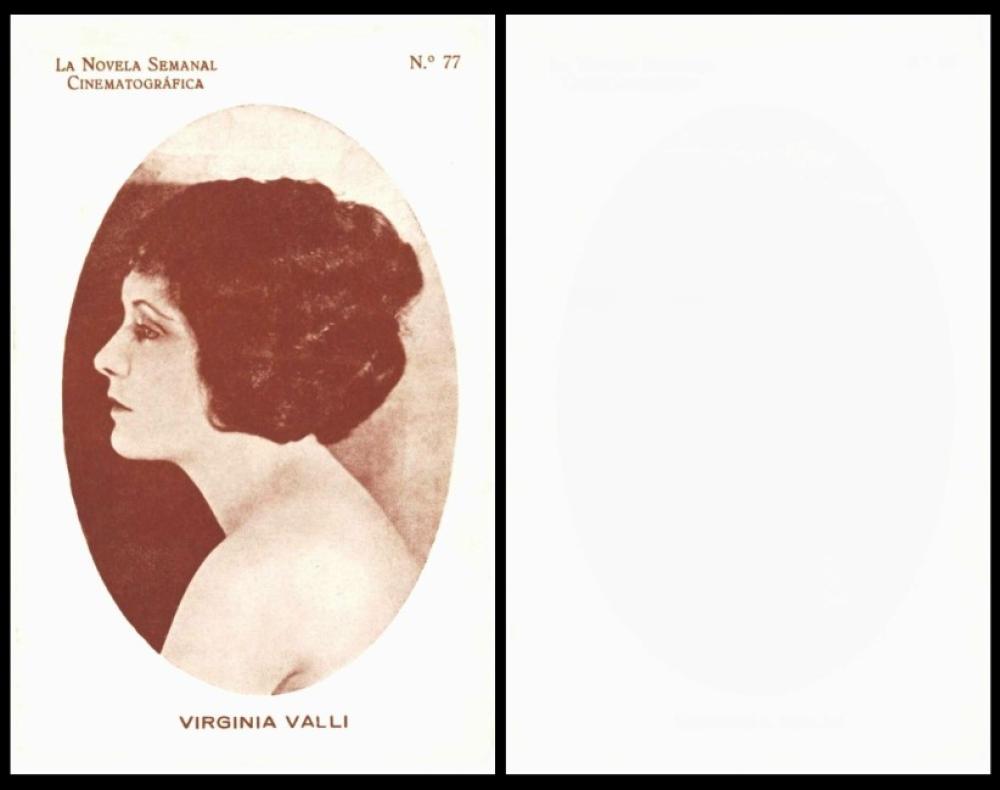
La Novela Semana Cinematographica [trade ; magazine : O/S : Spain] 77/
Now "La Novela Semanal" was a magazine which is often said to be South American but was actually Spanish and published in Barcelona. Though whether they had an export group I do not know. Yet. Semanal means weekly, so it was kind of like the weekly news, but it also had a sideline, which was printing cinema booklets, and novels based on films, and obviously these postcards, all under the name of "La Novela Semanal Cinematografie".
These cards were all plain backed, and though they are known as postcards there was never any attempt at adding a postcard back. Production of these cards seems to have started in the early 1920s. There are at least two hundred but I do not think they have yet been researched, or even listed.
This card shows a rather daring view of Virginia Valli - who was actually born in Chicago, today in 1898, and whose birth name was Virginia McSweeney. Like a lot of film stars, she started on the stage honing her craft, and then gave film acting a whirl. She seems to have started out with Essanay, when she would have been eighteen, and her first film was "The Strange Case of Mary Page" in 1916.
Twenty films later, in 1921, she was married to Demarest Franklin Lamson, who was a theatrical agent in Hollywood, and was known as George; he had been married before, and was ten years older than his new bride. The marriage lasted five years, and then the couple divorced.
In 1931 she married again, to film star Charles Farrell, it seems that she had already left the film industry, this is why there are not many cigarette cards of her, and I am not sure where they met. He had been appearing in a series of films with Janet Gaynor, designed to make it appear as if they were lovers in real life too, and these continued after he was married to Virginia Valli. However this second marriage was very successful and it lasted until she died in 1968. In fact they were married on Valentine`s Day.
The only true cigarette card I have found of her so far is Godfrey Phillips Cinema Stars (1929) 5/52, that says that her film career started in 1915, which probably makes more sense but she would have been under age then. It also tells us that she was five foot three, about a foot shorter than Charles Farrell, who was six foot two.
Cartophilic Centenary Card :
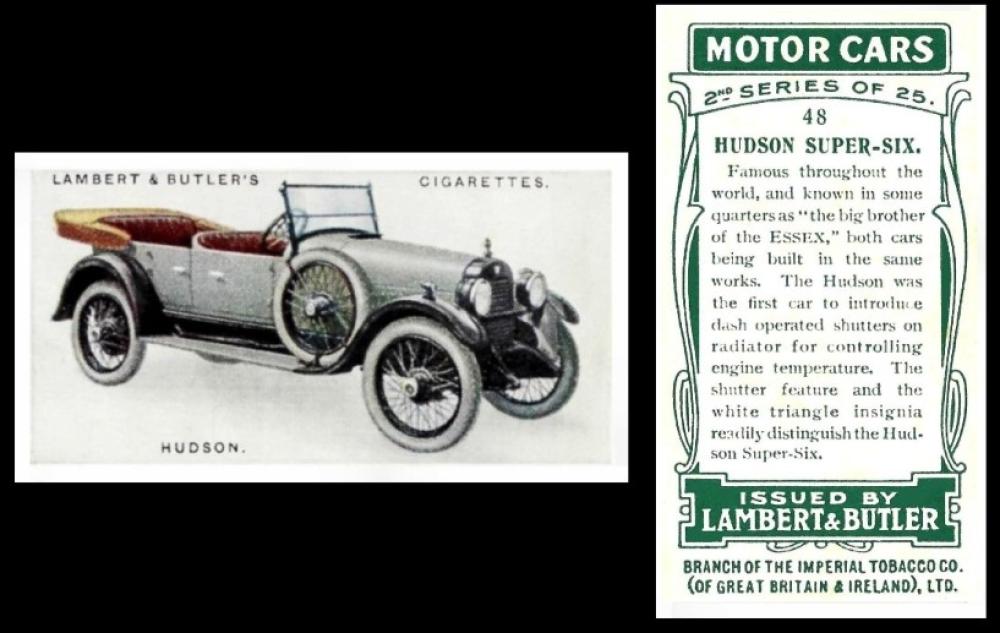
Lambert & Butler [tobacco : UK] "Motor Cars" 2nd series (11 June 1923) card 48 – L073-490.2 : L8-61.2 : O/71 (RB.9/71)
Now here we have an amazing fact, for look at the date above. There are relatively few sets that we can tie down to a month, let alone to a day, and yet we have this one, just in time for its centenary,
The Hudson Super Six, shown here, was first made by Hudson, or rather the Hudson Motor Car Company, of Detroit, in 1916. Though it looks like a standard car of the time it had almost double the horse power, and before being offered to the general public they had done a fair bit of speed trialling, as well as setting the record for a cross country drive from San Francisco to New York - it was just over five days.
The mention of the "Essex" needs a bit of explaining, for you will often read that was a vehicle by a different manufacturer, the Essex Motor Company, and it was made from 1918 to 1922, at which time it was bought out by Hudson. But the truth is that The Essex Motor Company was always owned by Hudson. There must have been some reason for this little white lie, and one day I will come across it...
This is one of those curious sets that I never know how to tackle for it is card 48 but the set is of 25 cards. This inevitably leads to me saying “card 48” Anyone have any ideas how to announce this in a way that makes it more sensible?
This set was first recorded in our original 1948 issued Reference Book, RB.9, to Lambert & Butler, in several stages, and each differently numbered. This is :
70. 25 MOTOR CARS. A series of 25. Fronts printed by letterpress, 4-colour half-tone process. Backs in green with descriptions, October 1922
71. 25 MOTOR CARS. 2nd series of 25. Similar format to (70). but different subjects. June 1923
72. 25 MOTOR CARS. 3rd Series, 50. Fronts printed by letterpress, 4-colour half-tone process. Backs in dark green with descriptions, March 1926
73. 25 MOTOR CARS (usually referred to as “Motor Cars” 1934). A series of 25. Fronts printed by letterpress, 4-colour half-tone process. Backs in green with descriptions, February 1934
In our original World Tobacco Issues Index this set is described as :
MOTOR CARS. Sm. Nd.
1. “A Series of 25”. Back in green
2. “2nd Series of 25”.
3. “3rd Series of 50”.
4. “A Series of 25. Back in grey.
And the only difference in our updated version is that our set now adds “(26/50)” after the entry in order to show the first card in that set is number 26
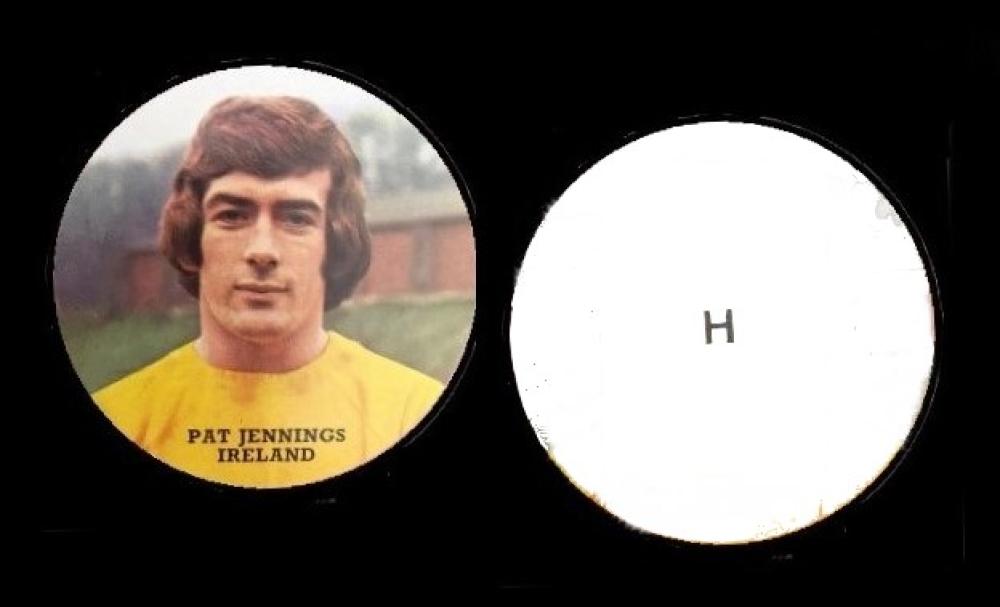
F.K.S. Publishers Ltd [trade/commercial : stickers : UK] “The Wonderful World of Soccer Stars 1972/73” stickers – untitled (1972) H/25 - FAA-8.2
A second soccer star for you this week as today in 1945 saw Patrick Anthony Jennings being born in Newry, Northern Ireland.
His start was with Shamrock Rovers Football Club, aged just eleven. But for some reason he decided instead to play the regional Gaelic Football, which is, forgive me the untechnicality, rather more like rugby. Aged sixteen he returned to football, with his home town heroes Newry Town, who had been enjoying a run of wins in the late 1950s.
His skill soon attracted the talent scouts and in 1963 he moved to England, and to the Watford Football Club just north west of London. This was for the quite substantial sum of £5,600.
Just over a year later he was off to Tottenham Hotspur, and the money had increased, to £27,000, perhaps because he was now an international player, with Northern Ireland . He played almst a hundred and twenty internationals for them. He also played for Arsenal, from 1977 until 1985. Then he rejoined Tottenham Hotspur as a reserve and as a goalkeeping coach.
Now this set was simply designed to fit in an album, and the first FKS album came along in 1966. It cost two shillings and sixpence, was printed in Spain and was called "A Full Colour Picture Gallery of World Cup Stars", and you might be mistaken for thinking it was not by FKS for nowhere does their name appear.
Citing their initials happened only with the second album, which was "The Wonderful World of Soccer Stars - 1967-68" and covered the England First Division only. It had gone up a shilling though. This album only says that F.K.S. were the publishers though, and also credits FHER, who we have mentioned in previous newsletters and as cards of the day. It is actually called a "picture stamp album" though, not a sticker album. By the way this album cover is identical to the following year, 1968-69, so do check up when buying. The only change is the date in the box at the bottom.
That title is slightly changed on the next album, to "The Wonderful World of Soccer Stars in Action - 1969-70", but there is a different image, and it has been reduced back to two shillings and sixpence. Again it only has stickers of the England First Division.
After a break for "World Cup Soccer Stars - Mexico 1970" things changed up a notch, and very importantly because their 1970-71 collection included not just the England First Division - there were also stickers of players from the Second Division as well as some of the stand out players of the World Cup and the European Cup. This seems to make it the catalyst for the massive sets of today. And the album also reflected another change because it had the normal price of two shillings and sixpence, along with the new decimal price of twelve pence ha`penny. (Or twelve and a half pence).
Sadly though this inclusion policy did not last and the next books were devoted to just the First Division again. And this included our set.
It was not until the following year, 1973-74, that World Cup Stars again made an appearance, obviously getting the collector excited for that event the following year.
Our British Trade Index part three describes this set as :
The Wonderful World of Soccer Stars 1972/73 (A). Two anonymous sections,
1. Football pictures, 72 x 49.Back in style of Fig.FAA-2. Nd. (330)
2. Circular portraits, see Fig.FAA-8-2. 60 m/m diameter. Back with letters A to Y. (25)
Now the back of the standard card has a dotted line a short way down the back, above which it says “Apply adhesive here only.”, and below which is the card number and title. And that might have been left out of this description was it not for the fact that it explains why these cards were called Picture Stamps and not Stickers, that being that these were issued before the time when the technology had been invented to allow you to just peel-and-stick.
And, by the way, the circular portrait chosen to be immortalised forever was none other than Pat Jennings, this very number!
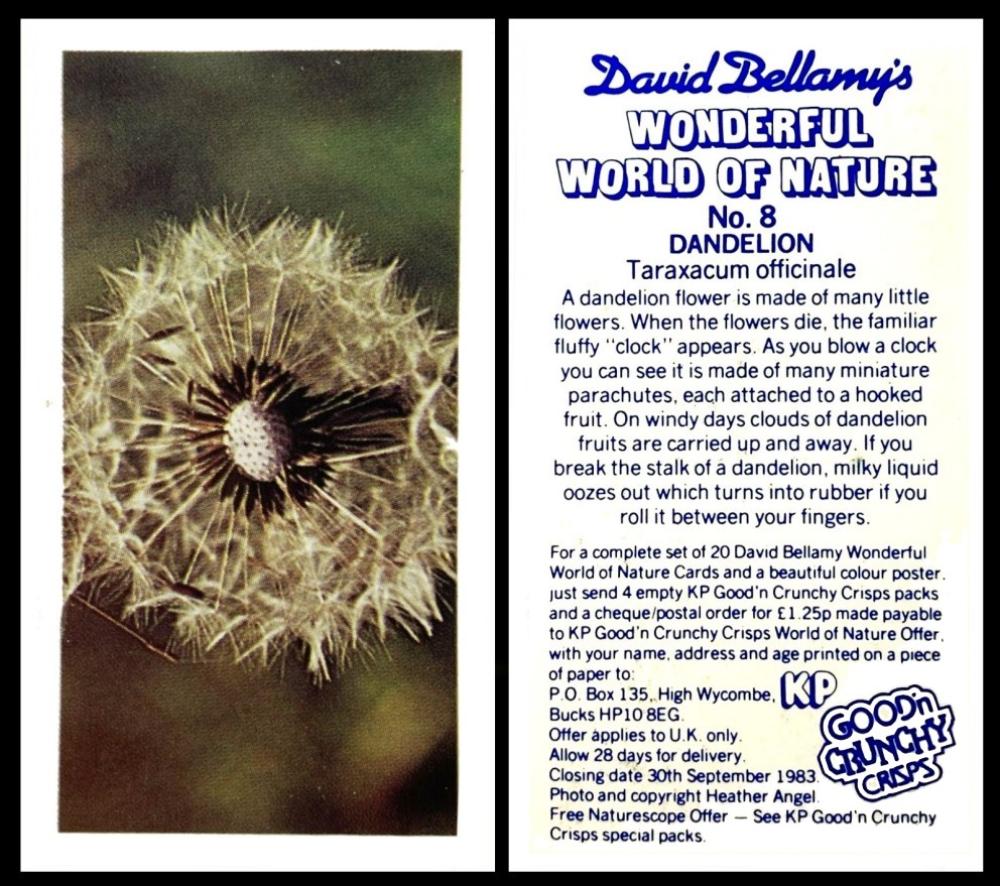
KP [trade : potato crisps : UK] “David Bellamy`s Wonderful World of Nature” 8/20 – JZA-3
Today is National Weed Your Garden Day.
But stop.
For a weed is just a flower in the wrong place and they can be just as beautiful, as well as providing food and shelter for a variety of insects which are not so keen on the flowers.
Here we have a weed that people just grub out. Yet it has beautiful bright yellow flowers that fade to these amazingly delicate seed heads. And its leaves are not only edible, but can increase your appetite, help your digestion and immune system. It is also given a proper Latin name of Taraxacum Officinale. And the card tells us that it is from a photo by Heather Angel.
The back tells us that “For a complete set of 20 David Bellamy`s Wonderful World of Nature cards and a beautiful colour poster just send 4 empty KP Good`n Crunchy Crisps packs and a cheque/postal order for £1.25p…” I am not sure whether by poster they mean wall chart, on which the cards were stuck. The closing date for the offer was the 30th of September 1983.
You can see the yellow and the white of the dandelion plantation together on Wills "Wild Flowers" second series (1937) 25/50. But there is an earlier card, CWS "Wayside Flowers" (1928), where it tells us that the name comes from the French "dent-de-lion", which mean`s "tooth of the lion". In case you were wondering what the lion and his teeth had to do with this flower, well it has nothing, it refers to the shape of the leaves m the French "dent de lion", meaning lion's tooth from the toothed edges to their leaves. Not sure I can see that myself, but I have found out that global warming is affecting those leaves and making them stronger in every way.
Maybe the plants of this world will have the last laugh over us after all
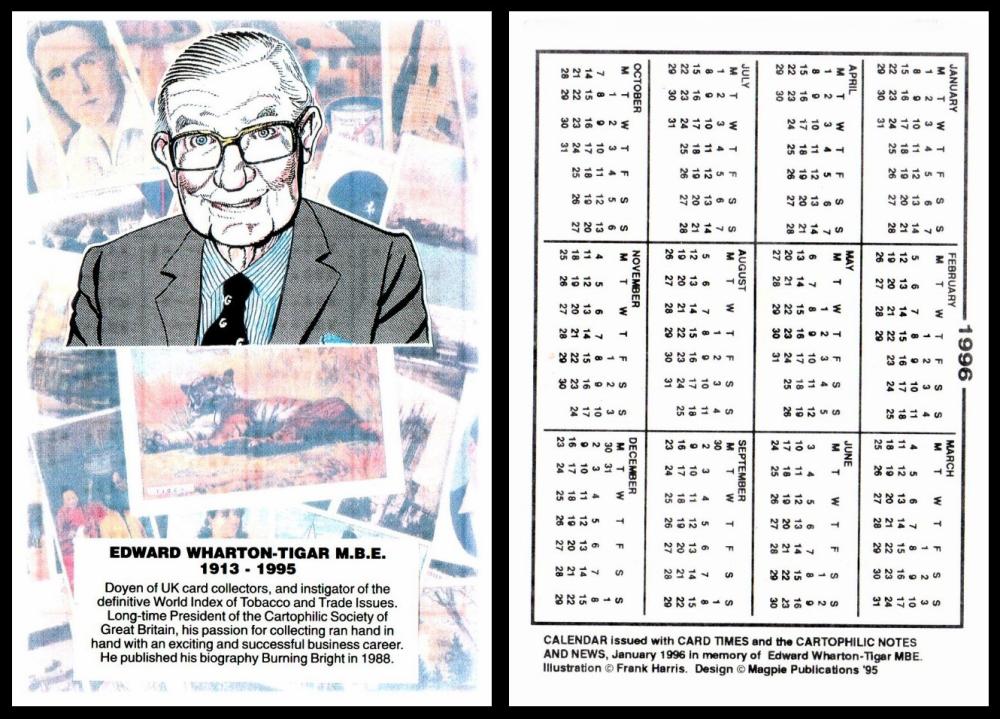
Card Times [trade : magazine : UK] “Calendar Cards” – untitled (1996) 1/1
Today a sad day, but there are happy memories too, for Edward Wharton-Tigar died today in 1994. We met when I came on the committee the first time round and he was much funnier than I had ever imagined, with a wealth of stories. His ability to charm almost certainly led to his success during the Second World War, when he was involved in espionage and resistance.
You can read a little bit more about him at https://csgb.co.uk/research/blog/wharton-tigar-edward - and this page will be updated through the week as a tribute - and there is also a photo of him in his younger days.
He took over a lot of jobs from Eric Gurd, including editoring our magazine and writing the reference books. It is also credited to him that these were replaced by the World Index, at the time a ground breaking volume which listed all tobacco cards issued everywhere in the world. I have to say that I treasure those small originals though, because they had scope to include so much more detail.
This card was issued by "Card Times", one of several calendar cards they issued. By the way if anyone needs any of these to complete their collection I have a few to swap.
And for younger readers, "Card Times" was a magazine, and it was run by David Stuckey. In fact it is still going strong, under new management, and the new name of "The Card Scene"
Cartophilic Centenary Card :
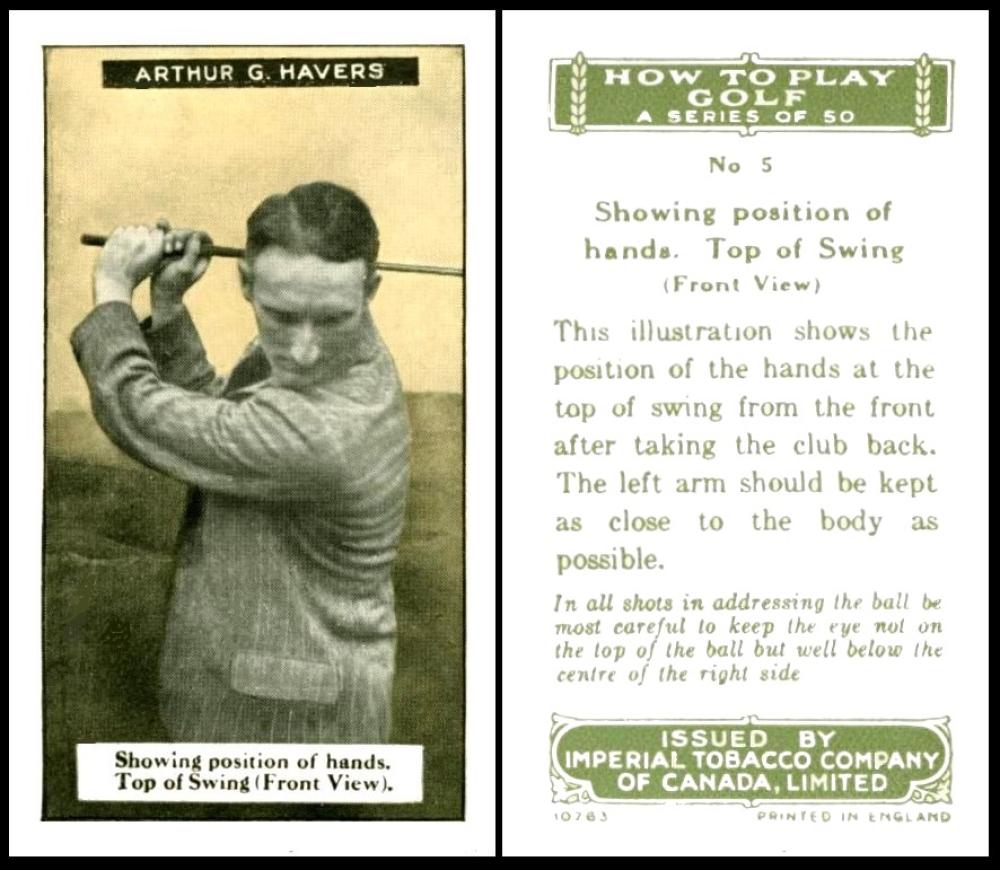
Imperial Tobacco Company of Canada [tobacco : O/S : Canada] "How to Play Golf" (1925) 5/50 - I.205-600 : I/6-27 : RB.21/309.B : USA/C.17
And many thanks to Mr. Pryor for this great card - and some additional gen!
As to why this is a Centenary Card, well it was today, in 1923 that this man, Arthur Gladstone Havers played Walter Hagen for the inaugural British Open Championship at Troon Golf Course.
Actually it had only just been the birthday of Arthur Havers, for he was born on the 10th of June 1898, in Norwich.
Now only a few years earlier the Royal Norwich Golf Club had also been born, in 1893. However there seems to be some dispute as to whether the "Royal" was Queen Victoria, or Edward VII. As for the connection between the course and Arthur Havers, well that is because he became the club professional there. As well as several other courses, by the way and quite far flung ones too. Not sure how he managed it.
He had turned professional in 1919. Presumably this was to take part in larger competitions, including the Northern Professional Championship, which he won in 1921 and 1922.
His fateful match for the Open, the following year was so close run that it was only the final hole that decided it, and a stroke of luck too, with an immaculate shot from the depths of a bunker. You may say this was a fluke. But he also won another big event at Gleneagles the following week. And he also, later, competed in the Ryder Cup.
The course at Troon had been first designed in 1878, and only expanded to eighteen holes in 1888. It was then redesigned by James Braid in 1923, just in time for the first British Open to be played at Troon, and he would be the only Briton to win for over a decade - until Henry Cotton won the 1934 event. We now call this course "The Old Course"
The really strange thing about our man is that here he is showing everyone how to play golf. But in his lifetime, and even today, his position was openly criticized for being neither rhythmical nor graceful - and so, still, says the website of the Open Championship. Maybe the truth is that he did not play in the style they wanted, yet still beat better players that did fit in. And for some reason that always leads to contempt - when it should lead to admiration.
I really do wonder what they said when they saw these cards though, showing of his skills and teaching other people to play the same way...!
So this set is first recorded in our Reference Book RB.21, the British American Tobacco Booklet, as :
309. HOW TO PLAY GOLF. Small cards size 62 x 38 m/m. Backs with descriptive text. Numbered series. Serial No.10763.
A) The British American Tobacco Company (Canada) Issue. Front in grey. Back in black. Series of 25, all demonstrated by Arthur G. Havers.
B) I.T.C. of Canada issue. Front with player in grey, yellow brown background. Back in green. Series of 50. Nos 1-25 as in A. Second 25 include demonstrations by Abe Mitchell and George Duncan.
Some of the Havers stances in the above two sets are similar to those in Morris` "Golf Strokes Series" but the background and descriptive text differ.
However in the World Tobacco Issues Index, the entry for our version, as you might imagine, is very much smaller, only "HOW TO PLAY GOLF Sm.67 x 38. Nd. (50) Serial 10763. See RB.21/309.B Ref USA/C.17
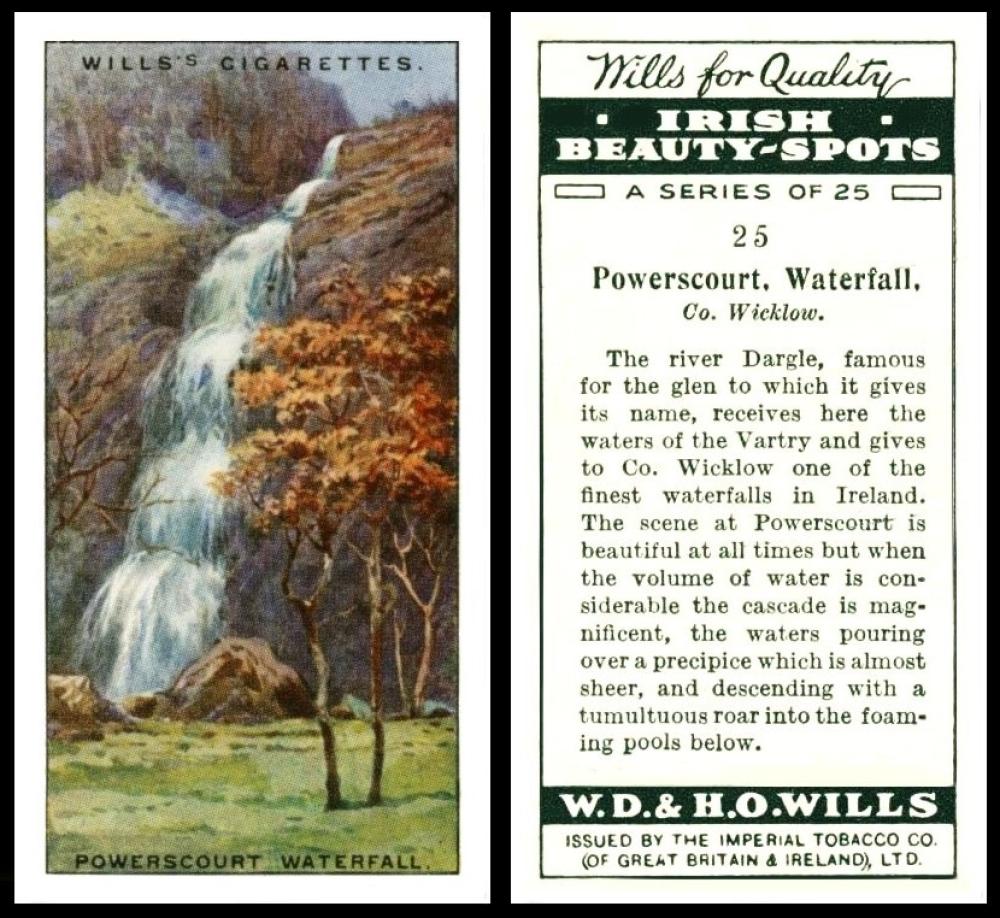
W.D. & H.O. Wills [tobacco : UK] “Irish Beauty Spots” (July 1929) 25/25 – W675-187 : W62-149 : W/243 (RB.16/243)
Today it is International Waterfall Day - but before you think of Niagara and Victoria Falls, there are many waterfalls in the British Isles. And in fact when water leaves a back garden pond and trickles into the next pond lower it is still a waterfall. So with that in mind go seek out your nearest.
Powerscourt is in the Wicklow Mountains and it is Ireland's highest at almost four hundred feet. This is odd because I have looked up Niagara and it says it is only a hundred and eighty eight feet. That puts Powerscourt into the lead, and yet who of you would name it first in the "name a waterfall category" at a quiz night?
In fact it is The Angel Falls in Venezuela which takes the trophy for the highest, at three thousand two hundred feet.
This set was recorded in our original 1950 issued Reference Book, RB.16, to W.D. & H.O. Wills, part four, as
25 IRISH BEAUTY SPOTS. Fronts printed by letterpress in colour. Back in grey, with descriptive text. Irish Issue, 1929.
Whilst our World Tobacco Issues Indexes list this as just "IRISH BEAUTY SPOTS. Sm. Nd. (25) Irish Issue". However do note that it comes before the adhesive backed cards.
According to the London Cigarette Card News, Vol.2, No.21, dated June 1935, this set was a companion to “Irish Holiday Resorts”, our set dealing with inland sights and the holiday one with the coastline. Or so Mr. H. D. Wilson said, anyway, and he was definitely the man to ask about Irish cards. He also tells us, in the same article, that :
Cigarette manufacturers in the Irish Free State have now apparently concentrated on issuing series of cards for distribution in the Free State only. Up to the present it has been the practice to follow the English issues, starting the issue in Ireland as soon as it was finished in England. Latterly however they have broken away altogether from this policy.
Practically the first issues of Irish interest only were “Irish Place Names”, in two series of 25 each, issued by Players, and “Treasures of Ireland”, a series of 25 issued by the same firm. Wills issued a series of 40 cards illustrating the building and working of the Shannon Electric Power Scheme. After that both firms returned to the English issues, but they have now once more returned to series of Irish interest only.
Then there follows a list, as above, but continuing with Wills` “Irish Holiday Resorts” and “Irish Beauty Spots” – and Player`s “Boxing”, “Famous Irish Greyhounds”, “Irish Rugby Players” and “Hurlers”.
This week's Cards of the Day...
proved to be really fascinating, for they were all related to Wednesday the 7th, which was June Bug Day Now though that calls this little creature a "bug", they are also called the June Beetle, or, rather oddly, the May Beetle. And there are lots of them, for their family, Phyllophaga, covers almost three hundred allied species of beetle, not counting the others in the same group of Scarab beetles.
As to why the June Bug is so called, well it is because in June, or sometimes late May, it comes out and enjoys the warm weather on its back, so that is when you will most likely see them scuttling about in the wood pile or across your gardens.
I have to say this was one of the most enjoyable themes, and there were also lots of beetle cards that I could have used. So maybe we will have another look at the insect world in the not so distant future....
Saturday, 3rd June 2023
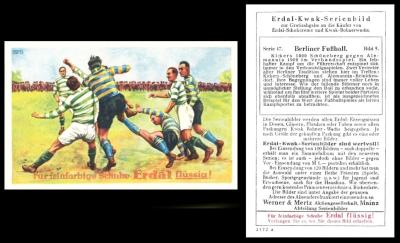
So we started with our regular Saturday Soccer Star, and this week we nipped over to Germany, for a spot of thrilling matchplay. But what we were after was the nickname of one of the teams, shown, Alemannia, which is "Kartoffel-Kafer" because they play in striped yellow and black jerseys. And this is the colour of a pest to local farmers, the Kartoffel--Kafer, or potato beetle.
And as an extra link, June bugs are actually Kafers too, or, in English, chafers. They are also double trouble, because the adults feed on vegetation, finding leaves especially tasty, whilst they lay their eggs underground so that when the young hatch they will be able to sustain themselves on the young and tender roots that they will almost immediately encounter beneath the soil. Another plant of choice is grass, which is probably the most plentiful species in most gardens.
Now there has been a lot of research done since this card was first used, including the fact that at first we classified it under E for Erdal. However we now know that this was a brand, operated by Werner & Mertz, of Mainz. And they are not only still in business, as Werner & Mertz GmbH, but it still a family company.
It all started in 1867, with a factory operated by Friedrich Christoph and Georg Werner, two brothers, which is why the company was called Gebruder Werner. Their business was selling waxes. They added a partner, another Georg, but with the surname of Mertz, hence Werner und Mertz. Sadly Herr Mertz died, in 1887, after which it was agreed that his brother in law took his place.
Their first real household name was "Erdal", which was shoe polish, and that was first marketed under that name in 1901, the same year that their new third partner also died, but yet again they kept it in the Mertz family and the new incumbent was the son in law of the man who had just gone. The name came from the street the factory was on, Erthalstrasse.
These cards are usually branded as "Erdal-Kwak", because "Kwak" was another of their brands, polish for floors. There was also "Blendol" which was metal polish, and that too is sometimes mentioned on the backs of their cards.
The shoe polish was made of natural substances, because there had been some criticism of shoe polish and its contents, which stained the clothing directly above it and also the hands of the user - no wonder, as most of it was either made from by-products of the coal industry, like sulphur and carbon, or from food-derivatives, including the discards of molasses that could not be eaten. They thought they needed a gimmick for their product, so they designed the character of the Frog-King, or "Rott Frosch" (red frog) in 1903, which was a frog, on a square of carpet, with a crown perched on his head. This was usually printed in red. However, once someone tried their shoe polish and found how well it worked, the little frog was not really needed.
Mind you I am not too sure what he has to do with polish, anyway, he comes from the story, recanted in Grimm`s Fairy Tales, and he was a Prince, turned into a frog, who met a Princess one day, and the two go home together. She does not really like him, but her father says she must be kind, and do his bidding, even let him sleep in her bed. And one day she finds that there is no longer a frog beside her, but a handsome prince. There is no kissing in the original story, that was added later, perhaps by parents who thought them sharing a bed was too risque.
In 1908, a fire broke out in the factory, and destroyed it, as you can imagine, with all that wax. There was also a second fire, in 1917, at their new premises. After that they had a purpose built factory built with a range of safety measures pre-installed, rather than adapted later.
In 1944 the factory was bombed by Allied forces, and most of it was again destroyed. Some of the workers there were captured prisoners of war, but it does not look like any of them were injured in the raid.
It was only in 1946, after the Second World War, that the company really diversified, into a range of household cleaners. Most of these were developed in house, using natural products, and this has turned into a great selling point as some of us become ever more eco-friendly. They dropped the use of all solvents in the mid 1990s, and now use only recycled plastic for their bottles. And in 2019 the current owner of the company, Reinhard Schneider, won the German Environment Prize.
The slogan on the bottom of this card is "Fur Fein Farbige Schuhe Erdal Flussig!". The first four words mean "For Fine Coloured Shoes", then "Erdal". However "Flussig", which I thought meant "polish" turns out to mean"free flowing", so it must have been liquid shoe polish. It was advertised as lasting longer and looking more beautiful for longer.
The albums for these sets were more like books, and the text was worked around empty spaces with framelines in which the cards were to be stuck. In these times they were not stickers, nor pre glued, you had to find your own glue.
This set is of just six cards, which are :
- Platzweihe des FC Weissensee 1900
- Hertha BSC - Holstein Kiel 4:2
- Norden-Nordwest-Berlin schägt Stettiner Preußen
- Tennis Borussia - Union-Oberschönwalde 4:0
- Kickers 1900 Schöneberg - Alemannia 1900
- Viktoria 1889 - SC Charlottenburg 10:1
Sunday, 4th June 2023
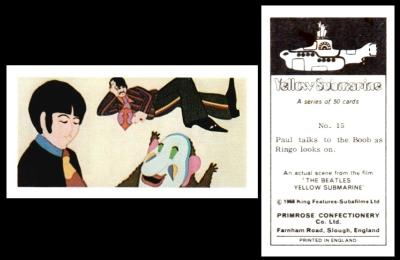
So here we have clue two to this week`s theme, and that showed the fab four, John, Paul, George and Ringo, otherwise known as "The Beatles".
It may seem odd that a pop group was called after an insect, and I am not sure I believe the story that it came from Marlon Brando`s dialogue in "The Wild Ones" where he referred to his gang, and their leather motorcycle clothing, as "young beetles'". For one thing the group were not really rough in their appearance, or attire, and though it is often said that they were trying to be subversive by inserting references to drugs within their songs, I do not ever think of them as being rebels. Or dressed in leather.
Now this is quite a sought after set, and by music fans too, for it is taken from stills from their 1968 animated film "Yellow Submarine".
Actually there are two other sets that I know of which feature this film.
The vintage one was a set of 66 cards, issued by Anglo Confectionery, in the same year, 1968, but the cards are larger and on a greyer thicker board.
The more modern one was a set of 72 cards produced by Duocards in 1999. .
Primrose Confectionery Ltd were based at Farnham Road in Slough. They started after the Second World War, once rationing allowed, and it seems that they kept going until the 1980s. A lot of their sets have added interest because they feature film and television characters, including Amos Burke, Dad`s Army, Laurel and Hardy, Laramie, Popeye, Star Trek, Superman, and Z-Cars.
It seems like they first issued cards in 1960, and three sets are recorded as being that year. The standard sets are "Andy Pandy" and the first of four series of "Popeye", from the children`s television programmes of the same name. Then there was a very unusual set of 22 pictures on the Canadian Mounties which was a package issue, and had to be cut out by the collector. However I have not been able to find any new issues reports on these in our magazine. I did find something intriguing though, and that was in Cartophily Britannica, Bill Wareham`s magazine, where he states that the second series of Popeye was issued in about November 1960.
Their cards were mostly issued with sweet cigarettes, or, in later years, candy sticks, and the boxes that they came in are now even more collectable, because when the original consumers ate the sweets they threw the packets away.
This set is listed in our original British Trade Index part two, (RB.27). The header says that Primrose cards were issued between 1958 and 1968, because this book was published in 1969. It also tells us that special albums were issued, and that some of the cards, but not ours, were inscribed "F.B.S.1" but did not have the firm`s name. There was also mention of an anonymous set listed as ZB9-11, but that does not seem to exist. As far as the description of this set, it is only "YELLOW SUBMARINE. Sm. 64 x 33. Nd. (50)"
Our updated British Trade Index has the same description.
I may be able to track down the original new issues report by Saturday though.
Monday, 5th June 2023
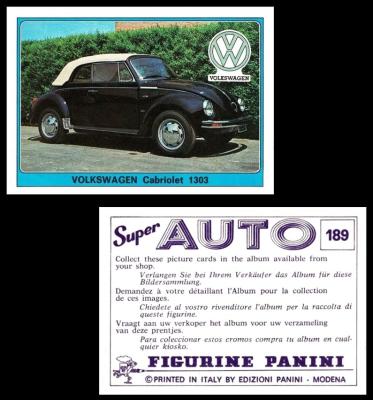
And lastly, on Monday, we have a motorised "Beetle", one of the most popular Volkswagen models ever, and one of which, coincidentally, was the first car I ever owned. It was dark blue.
Apparently the name "Beetle" was coined by the New York Times in 1938, who thought the car looked like a beetle with its sloping hard shelled form. Its original German name of "Volks Wagen" actually meant "People`s Car", because it was designed as a cheap car for normal people. And kudos to Volkswagen because they have recently stopped paying for twitter adverts and set up sites on the way friendlier, and ethical, mastodon social media. Check them out at @VWGroup and @Cariad_Tech
This is a great set of cards, and it starts with racing drivers from Formulas One, Two and Three, as well as rally drivers. From card 43 the race cars themselves take centre stage, and then from card 47 they work through road cars in alphabetical order starting with the Alfa Romeo S.p.A. (though it is a bit confusing because card 46 is also an Alfa Romeo, but that is part of the race car section). Around number 100 they briefly return to motor racing again, kind of like a highlights reel. Then they resume with the second half of the alphabet and end with card 195, showing the ZAZ 968-A. The final five cards are "cross country" vehicles, and that includes the trusty Land Rover, at last.
Now the ZAZ was a really unusual vehicle, being rear wheel drive and built as early as 1958 in Ukraine. To all intents and purposes they were an early attempt at a smart car, though they followed the Volkswagen as well by being designed as a people`s car. Sadly, despite many upgrades, the idea never really took off and the last one was made in 1994.
Tuesday, 6th June 2023
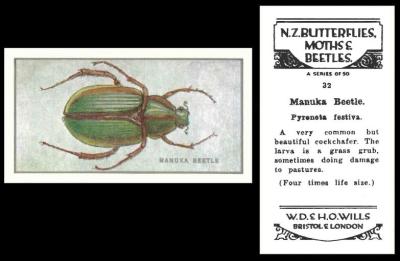
So our first real beetle of the week is this one. It is described as the Manuka Beetle and given the scientific name of the Pyrenata Festiva.
The text, which can be extremely blurry on some of these cards, tells us it is "A very common but beautiful cockchafer" and that the card shows it "four times life size".
According to my research, though this beetle is related to the rest of the cockchafer family, which is spread all over the world, this particular species only appears in New Zealand. I also read a curious reference that when wool was imported to England the beetles were found in it, but it left me hanging there, and I was eager to know whether the beetles were alive, and what they did with them, or if they did not survive in our climate. Or maybe they could only eat off the manuka tree? And yes, this is where the honey comes from.
This set appears in our original Wills Reference Book part 4 as :
277. 50 N.Z. BUTTERFLIES, MOTHS & BEETLES. Printed by letterpress in colour. Backs in grey, with descriptive text. New Zealand issue 1928.
There is no month of issue given there, and not in the modern Wills Combined when all the books were printed as one volume with the addition of a very useful table of issuing dates taken from the Wills Works Magazine.
Both our World Tobacco Issues Index sees the description reduced to : "Sm. Nd. (50)"
Wednesday, 7th June 2023
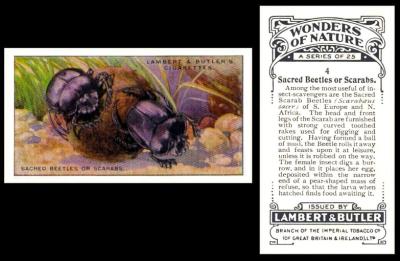
So here we have the dung beetle. They are found everywhere except for Antarctica. Indeed, they are probably the best known of all beetles, and by all ages, for children revel in the thought that they spend their whole life playing with, living in, and eating what I shall call "dung" - and adults celebrate the fact that they were revered by so many cultures including the Ancient Egyptians, who completely worshipped them, knew them as the scarab, and believed that the Sun God Chepri spent his life rolling the sun around the Earth, burying it when the sun went down and raising it again the next morning. And he was a striking chap, having the body of a man, but the head of a dung beetle, with long antenna too.
Strangely, though, when W.D. & H.O. Wills produced their set of "Lucky Charms", and featured The Scarab as card 20/50, they chose to come over all coy, and to write in their text that the Scarab Beetle "..rolls each of its eggs in a ball of mud."
Our original Lambert & Butler Reference Book (RB.9 - published in 1948) described this set as :
100. 25. WONDERS OF NATURE. Fronts printed by letterpress, 4-colour half-tone process. Backs in black, with descriptions. 1924.
In our World Tobacco Issues Indexes, the description was reduced to : "Sm. Nd. (25)"
Thursday, 8th June 2023
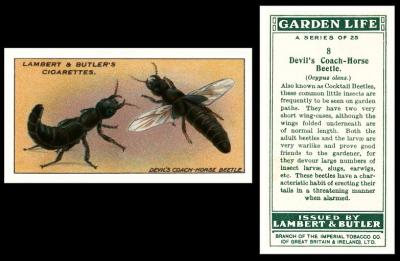
You may think this a curious creature, but it is quite usual to find them in hedgerows, scuttling along. and also in gardens, if you hunt under stones, though they also like the warmth of the compost heap. They are often mistaken for a scorpion, from the colour and from the curling action of their "tail" but this is just an elongated stomach and it does not sting, it only squirts a kind of smelly soup, which lingers despite washing.
However do let the "Devil" part of their name be a warning, for once roused they are mighty fighters, with strong pincer like jaws, capable of crushing other insects and giving a nasty nip to any intruding human fingers. And some people, especially children, are badly affected by them though, and suffer large blisters if they attempt to pick up the insect. It is thought that this is because many children start to crush it and then the beetle responds in the only way it can.
Now some places call this creature the cocktail beetle, but I have not discovered why, yet.
Our original Lambert & Butler Reference Book (RB.9 - published in 1948) described this set as :
49. 25. GARDEN LIFE. Fronts lithographed in colour without photo basis. Backs in dark green, with descriptions. 1930.
In our World Tobacco Issues Indexes, the description was reduced to : "Sm. Nd. (25)"
However there is another code above, the H code for the handbook, and this tells us that this set was not a one off, instead being issued by W.D. & H.O. Wills in October 1914, some sixteen years before our version, and also by Edwards, Ringer and Bigg in 1934, four years after ours, and twenty years after the original Wills printing.
Sadly there is no Edwards Ringer and Bigg Reference Book, but I do have a contemporary new issues report from The London Cigarette Card Company`s "Cigarette Card News" Vol.2, No.13, October 1934, under "Notes on Current Series - by C. L. Porter" which reads :
Edwards, Ringer & Bigg. This branch of the Imperial Tobacco Company are now packing in their "Klondyke" Cigarettes "Garden Life", a series of 25 small cards, similar to the Lambert & Butler set of the same name."
Now this does not mention the Wills original set, but the reason could be something which is revealed in our Wills Reference Book, where it tells us their original set was a series of fifty cards, double the size of the other two. So how, I wonder, were the cards selected? And did both those sets use the same cards and numbering system?
Friday, 9th June 2023

Our last beetle of the week has travelled far to be here and was part of a long running series. They are kind of "missing link" cards, because they were not issued with tobacco, which rules out them being recorded in the World Tobacco Issues Index and they were issued in Australia, so are not in the British Trade Index. However there is a magical pair of volumes called the Australian and New Zealand Indexes, which record all issues of the Antipodes, whether they be trade or tobacco. Volume one is out of print and hard to find, though I got mine fairly cheaply on eBay, but volume two is still on sale from our bookshop.
The listing for this card is in Volume one (RB.30 - published in 1983) and provided the important information that the cards were issued by the Service Stations, so rather than buying something and finding the card inside you would be given it at the till. The header tells us that they were issued in Australia, and that these were inscribed "Shell" without the full name. In other words it is just either the shell shaped logo with "Shell" nestling within, or simply the word "Shell".
The beetles set was part of a bigger issue that ran from 1959 until 1965, nine sets in all, and five hundred and forty cards.
There was a bit of a mix up though, and one of the sets, possibly two, were wrongly numbered. "Citizenship" carries the numbers 1-60, which had already been used by "Discover Australia with Shell", and "Meteorology" is recorded as being numbered from 261 - 420 which is obviously wrong as it was a set of sixty only, and also some of those numbers are also used by another set, "Transportation".
Having had a look into this it seems more likely that the sets were issued in the following order
-
Discover Australia series 1 = 1 - 60
-
Discover Australia series 2 = 61 - 120
-
Discover Australia series 3 = 121 - 180
-
Discover Australia series 4 - 181 - 240
-
Project Cards - Transportation - 241 - 300
-
Picture Cards - Beetle Series = 301 - 360
-
Project Cards - Meteorology - listed as 261-420 - actually 361 - 420
-
Project Cards - Citizenship - numbered 1 -60 - actually 421 - 480
There was also another set "Picture Cards - Pets". This came last but was never issued. However, rather cryptically, it is recorded that "remainders became available"
Well we got there in the end. If I had only had more time in the week. Lets see what I can do by starting tomorrow. Though some of you might say, and correctly, that I could be less wordy. And this is true, partially, because when I start going through the magazines I will be adding all kinds of other info. However that may be a while away.
On which note the index of cards of the day is going very well now that I have a system. And I am coping with the doubles, of which there have been surprisingly few. However I have temporarily been forced to halt to sort out the Borough Arms so that I can make a note of which I have and which I do not. This ought to be finished overnight and then I can continue with the index in the morning.
So may I thank you again for your patience, and also to those wonderful collectors who saved me when I had no cards for Pat Jennings and Arthur G Havers. As I said in the original frontispiece it would be glorious indeed if we could all collaborate on these newsletters. I am unsure how this would work though. But it is something that I need to think about. My only thought is that maybe I could upload a list of subjects that I need cards for and see what I get sent by the Friday. But I am not sure if this would spoil the surprise that you get when you first open the newsletter.
And when the gallery is done, perhaps we will find a way to add a section in the newsletter for cards that have not yet featured....
On that exciting thought, best wishes until next week, and always - from us all
